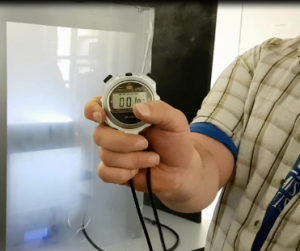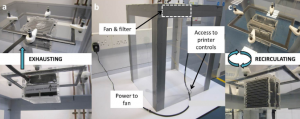With innovation always comes unintended consequences. There’s been much-to-do with the possible health repercussions of 3D printing, particularly when it comes to the fine particles and fumes produced by the process.
Some 3D printers on the market now carry HEPA (High Efficiency Particulate Air) filters and come with their own safety enclosures. But their effectiveness has not been studied extensively, and therefore certain universal safety standards have yet to be established.
Now, recent research on the danger of these chemicals and the effectiveness of enclosures could make us someday look at 3D printing without one like we now look at smoking on airplanes.
The Danger of FFF Emissions
The research about fumes from 3D printing filaments is not yet conclusive. However, some studies have shown that ABS (Acrylonitrile Butadiene Styrene) is a particularly bad offender in emitting high levels of styrene, a known carcinogen, into the air.
More research by the National Institute for Occupational Safety and Health (NIOSH) studied the effects of these fumes on rats. As told to 3DPrint.com last October:
Rats exposed for 1 hour to particle and vapor emissions from a FDM 3-D printer using ABS filament (a type of plastic material) developed acute hypertension, indicating the potential for cardiovascular effects. In another NIOSH research study, lung cells exposed to FDM 3-D printer emissions from printing with ABS and polycarbonate for about 3 hours showed signs of cell damage, cell death, and release of chemicals associated with inflammation, suggesting potential for adverse effects to the lungs if emissions are inhaled.
While the organization cautions that these findings need confirmation with more extensive research, it’s probably self-evident that fumes from hot biochemicals + lungs = bad.
That’s why the Health and Safety Executive (the UK’s version of NIOSH) isn’t waiting around for an official declaration before working toward safer 3D printing standards.
The Effects of a Vented Enclosure System
To study the effectiveness of a vented enclosure system, the Health and Safety Executive team created the Exposure Control Cabinet. The ECC is a small glass chamber in which the 3D printer rests. On the roof of the cube is a small fan which could be set to A) do nothing, B) recirculate the air within the chamber, or C) exhaust the air up and out of the cube.
To measure emission rates and particle concentrations, common additives ABS and Polylactic Acid (PLA) were used, respectively. To measure the efficiency and effectiveness of the chamber’s three settings, the ECC was first filled with smoked then timed until the smoke was completely removed.
The results were encouraging to say the least, with the exhaust and recirculation settings clearing 97-99.4% of the smoke over a 20 minute period. In their conclusion, the team suggests that in a controlled environment (like the ECC), the rate at which particles are released into the air by 3D printers is reduced by up to 99%.
The Beginning of New Standards (And A New Industry)?
While it might seem obvious that air control would make workplace air safer, the Health and Safety Executive’s findings are an important step in developing safety standards for 3D printing, both at home and on an industrial scale.
Like how you (hopefully) wouldn’t operate certain power tools without eye protection, this kind of data is a small step in making sure quality air control is as important and basic as not touching a hot 3D printing nozzle or chewing on your filament. Using an ECC (or something like it) could become an important mandatory safety standard to have in place at maker’s labs, high school shop classes, and other places using 3D printers.
And should their use become mandatory in settings like these, vented enclosures could become big business. While there are many DIY recipes for vented 3D printing enclosures online, it’s largely an untapped commercial market.
Until then, or until research proves otherwise, we’ll just have to let common sense prevail and recommend operating printers in open areas with good air circulation.
Discuss this and other 3D printing topics at 3DPrintBoard.com or share your thoughts below.
Source: Health and Safety Executive (ResearchGate)




121 Replies to “Should Vented Enclosures Become A Mandatory Safety Standard for FFF 3D Printers?”
Comments are closed.